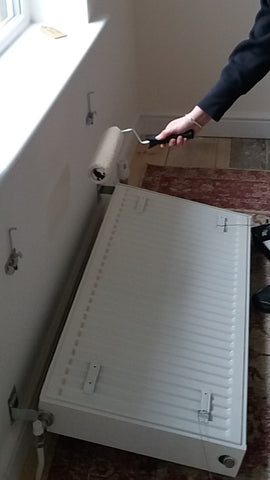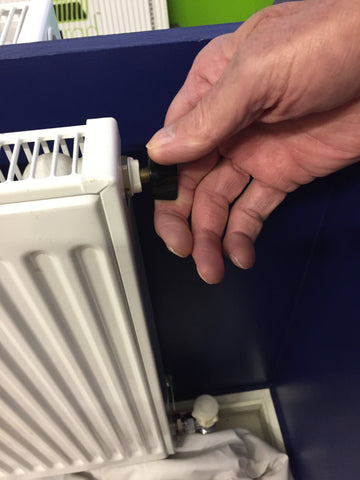
Removing Central Heating Radiators
Removing a radiator can be a difficult task if you don’t know how to remove it or can be quite costly if you need to call out your local plumber to remove and then to replace it!
If the radiator is a large one you may need two people to lift the radiator from its brackets.
You may find it necessary to remove a radiator from the wall, perhaps to re-plaster behind it, or to paper behind it and for a deep clean.
Painting Behind Radiators
Removal of the radiator is necessary when painting behind the wall as you can normally paint behind with a long-handled paint roller.
However, this can be quite a messy job and is not guaranteed you will cover the wall completely!
See blog – How To Paint Behind A Radiator without Removing it

Wallpapering Behind A Radiator
Wallpapering behind a radiator also requires removal of the radiator as this can become quite fidgety and a messy job trying to get the wallpaper behind the radiator when it is fixed to the wall.
How To Remove The Radiator From The Wall For Decorating
Cleaning Behind A Radiator
Radiators are designed in such a way that dust and dirt can become trapped there quite easily and it takes a considerable amount of time to make sure it’s all removed.
If you leave the dust on your radiators your central heating will become less effective, which means that it will have to work harder, which costs more energy and more money!
It is recommended that you get into the habit of thoroughly cleaning your radiators at least once a year- especially in the summer months when the heating is switched off.
See Blog – How To Remove Central Heating Radiators To Clean Behind

How to Remove Your Radiator From The Wall?
There are normally two valves, one at either end of the radiator.
One is the flow and returns valve and the other valve is a lockshield valve and the other is a manual control valve or thermostatic valve.
On the left is a lockshield valve, the middle is a thermostatic valve and the one on the right is a lockshield with drain off.
The drain off valve can be used to drain the individual radiator or can be used to drain off the whole system.
What You Need To Remove A Radiator
- A spanner to fit the nut which connects the valve to the radiator.
- A set of water pump pliers to hold the valve whilst undoing the connecting nut.
- Radiator bleed key.
- Old dust sheets and a bowl to catch the water
1. Close the manual valve by turning it clockwise

2. Close the lockshield valve using a suitable spanner. This will close in a clockwise direction.

3. Using a dust sheet, position the bowl to collect the water. Beware the water can be dirty when draining out.

4. The bleed valve needs opening so that the water inside can be replaced with air so undo this using a radiator bleed key, once the valve has been opened the water from the radiator will exit the radiator a little faster.

5. Using the 2 spanners release the water from the radiator.

Once you are sure the radiator is empty of water undo the two union nuts which are fastened to the radiator.
To do this grab the valves with a pair of water pump pliers which will prevent the pipes from being damaged when undoing the union nuts.
Make sure you cap the radiator thermostatic valve as if this is not done could cause flooding in the house.
Reposition bowl to collect water from the other side of the radiator.
Steps to Refit The Radiator
- Lift the radiator back onto the brackets
- Fasten both of the valve retaining nuts – making sure they are tight and won't leak!
- Open the lockshield valve first
- Open the manual valve or thermostatic valve – double check for leaks
- Undo the bleed screw to let in the air, when the water exits from the bleed valve close it off
- Check the pressure of the boiler and top up if required
- Question - Why should you have to remove a radiator to achieve satisfactory hygiene or improved decorating results??
- Answer – You should consider moving a radiator for full access and not removing a radiator to make the task of cleaning your radiators more practical for stress-free periodic cleaning and for decorating
Conclusion
To overcome this messy and time-consuming process this is now the ideal time to consider installing a Rotarad radiator conversion kit which allows full instant access for cleaning and decorating.


